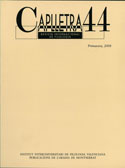Posició i funció dels connectors «a més (a més)», «però» i «doncs» en català escrit i oral
DOI:
https://doi.org/10.7203/caplletra.44.4805Keywords:
Connectors, Oral Language, Distribution Abstract
Abstract
This article is an approach to the study of the syntactic positions that parentetic connectors take in oral discourse in Catalan –in sentential segments particularly– based on the analysis of three connectors with different meanings: «a més a més» (additive), «però» (contrastive) and «doncs» (consecutive). The methodology used is contrastive: firstly, the positions in which all three linking words stand in a corpus of written language (written press) are studied, and secondly, the results obtained are
compared with datum coming from an oral corpus constituted mainly of monologic texts. The comparison brings to light that conditions of production of oral modality (immediateness, lack of planning, etc) force to resorting to own strategies to guarantee
the connection of the text, like reinforcing a conjunction with a parentetic connector («a més a més»), to promote the conjunctive use of a connector («però») and to assure the connection among subject-rheme («doncs»)
 Downloads
Downloads
Downloads
Published
How to Cite
-
Abstract559
-
PDF (Català)125
Issue
Section
License
Authors submitting work to Caplletra for publication must be the legitimate holder of the usage rights. Legitimacy for the purposes of publishing the work must also include images, tables, diagrams and any other materials that may complement the text, whether they are the author of such material or not.
Copyright: on publishing their work in the journal, the author grants Caplletra. Revista Internacional de Filologia usage rights (reproduction, distribution and public communication) for both the paper printed version and for the electronic version.
All work published in Caplletra is covered by the Creative Commons license type Attribution-NonCommercial-NoDerivatives 4.0 (CC BY-NC-ND 4.0).
RESPONSABILITY
Caplletra. Revista Internacional de Filologia does not necessarily identify with the points of view expressed in the papers it publishes.
Caplletra. Revista Internacional de Filologia accepts no responsibility whatsoever for any eventual infringement of intellectual property rights on the part of authors.






